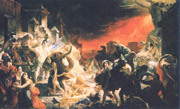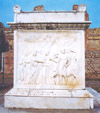
MOUNT VESUVIUS
The eruption of 7 9 A. D. radically changed the shape of the volcano.
The steep volcanic cone collapsed leaving a crater with a perimeter of 11 kilometres. Today this is known as Mount Somma and is 1,132 metres high. Inside this, a new cone formed rising to 1,277 metres to give the modern day appearance of the volcano. Vesuvius erupted eleven times in the following 12 centuries, most violent occurred in 113 9 of these eruptions. The eruptions then became less frequent and in the 10 century there was a long period of inactivity. During this time the volcano was covered in lush vegetation.
In the late XVI century there were various tremors which were almost a forewarning of the catastrophic eruption that was to take place on 16 December 1631.
This eruption was almost equal in violence to that of 79 A.D. and caused the deaths of approximately 4,000 people.
Other violent eruptions followed, such as the one in 1707 when the Austrian garrison was stationed in Naples, and that of 1794 which destroyed Torre del Greco. There were other major eruptions in 1895 and 1899. Then the eruptions of 1906 and 1944 took place, the sad memories of which still live on in the minds of the people living around Mount Vesuvius.
1845 saw the setting up of Mount Vesuvius Observatory near the crater at Herculaneum. It is a scientific station which keeps a constantly vigilant eye on the volcano’s activity as Vesuvius certainly cannot be said to be completely dormant. This can be seen from the wisps of smoke inside the crater and from a moderate amount of seismic activity.






